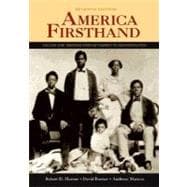
Note: Supplemental materials are not guaranteed with Rental or Used book purchases.
Purchase Benefits
What is included with this book?
| Preface | vii | ||||
| Studying and Writing History | xi | ||||
| PART ONE Indians and Europeans: New World Encounters | 1 | (40) | |||
|
|||||
|
3 | (4) | |||
|
|||||
|
|||||
|
7 | (36) | |||
|
|||||
|
|||||
|
13 | (1) | |||
|
14 | (5) | |||
|
|||||
|
|||||
|
19 | (4) | |||
|
|||||
|
|||||
|
23 | (6) | |||
|
|||||
|
|||||
|
29 | (6) | |||
|
|||||
|
|||||
|
35 | (6) | |||
| PART TWO The Colonial Experience: A Rapidly Changing Society | 41 | (52) | |||
|
|||||
|
43 | (5) | |||
|
|||||
|
|||||
|
48 | (8) | |||
|
|||||
|
|||||
|
56 | (1) | |||
|
57 | (5) | |||
|
|||||
|
|||||
|
62 | (1) | |||
|
|||||
|
|||||
|
66 | (1) | |||
|
|||||
|
|||||
|
72 | (1) | |||
|
|||||
|
|||||
|
81 | (12) | |||
| PART THREE Resistance and Revolution: Struggling for Liberty | 93 | (48) | |||
|
|||||
|
94 | (13) | |||
|
|||||
|
|||||
|
98 | (8) | |||
|
|||||
|
|||||
|
106 | (1) | |||
|
107 | (1) | |||
|
|||||
|
|||||
|
109 | (1) | |||
|
|||||
|
|||||
|
117 | (1) | |||
|
|||||
|
|||||
|
123 | (1) | |||
|
|||||
|
|||||
|
128 | (1) | |||
|
|||||
|
|||||
|
135 | (1) | |||
|
|||||
|
|||||
| PART FOUR Defining America: The Expanding Nation | 141 | (60) | |||
|
|||||
|
143 | (12) | |||
|
|||||
|
|||||
|
148 | (6) | |||
|
|||||
|
|||||
|
154 | (1) | |||
|
155 | (1) | |||
|
|||||
|
|||||
|
160 | (1) | |||
|
|||||
|
|||||
|
168 | (1) | |||
|
|||||
|
|||||
|
173 | (1) | |||
|
|||||
|
|||||
|
180 | (1) | |||
|
|||||
|
|||||
|
188 | (1) | |||
|
|||||
|
|||||
|
197 | (1) | |||
|
|||||
|
|||||
| PART FIVE An Age of Reform: Rearranging Social Patterns | 201 | (66) | |||
|
|||||
|
202 | (16) | |||
|
|||||
|
|||||
|
209 | (8) | |||
|
|||||
|
|||||
|
217 | (1) | |||
|
218 | (1) | |||
|
|||||
|
|||||
|
226 | (1) | |||
|
|||||
|
|||||
|
233 | (1) | |||
|
|||||
|
|||||
|
241 | (1) | |||
|
|||||
|
|||||
|
249 | (1) | |||
|
|||||
|
|||||
|
257 | (10) | |||
| PART SIX Civil War and Reconstruction: The Price of War | 267 | ||||
|
|||||
|
268 | (11) | |||
|
|||||
|
|||||
|
275 | (3) | |||
|
|||||
|
|||||
|
278 | (1) | |||
|
279 | (1) | |||
|
|||||
|
|||||
|
289 | (1) | |||
|
|||||
|
|||||
|
297 | (1) | |||
|
|||||
|
|||||
|
306 | (1) | |||
|
|||||
|
|||||
|
312 | (1) | |||
|
|||||
|
|||||
|
320 | (1) | |||
|
|||||
|
The New copy of this book will include any supplemental materials advertised. Please check the title of the book to determine if it should include any access cards, study guides, lab manuals, CDs, etc.
The Used, Rental and eBook copies of this book are not guaranteed to include any supplemental materials. Typically, only the book itself is included. This is true even if the title states it includes any access cards, study guides, lab manuals, CDs, etc.